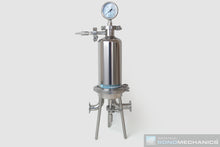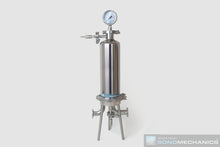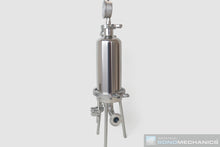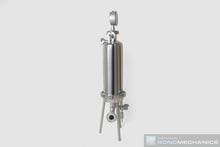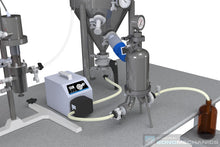
Filtration through a hydrophilic membrane is an important post-processing step of ultrasonic nano-emulsification, which removes particulate contamination such as dust, microorganisms, plant matter, and titanium particles. These large- and ultra large-capacity in-line filter assemblies include a stainless steel housing and a replaceable hydrophilic-membrane filter cartridge. We recommend using the large-capacity assembly with the BSP-1200 processor and the ultra large-capacity assembly with the ISP-3600 processor.
The included replaceable filter cartridge membranes have either 0.22 micron or 1 micron pore sizes and can be used to filter translucent nanoemulsions made with NanoStabilizer®-LT or opaque nanoemulsions made with NanoStabilizer®-LSO, respectively. Replacement cartridges for both housing types and pore sizes are available here. All cartridges are capable of handling substantial nanoemulsion volumes and can be cleaned by back-flushing with purified water and reused many times.
Typical lead time to shipping: 2 weeks.
- Remove particulate contaminants (dust, microorganisms, plant matter, titanium particles).
- Filter nanoemulsions without rejecting any of the bioactive-containing oil droplets.
- Achieve greater product stability and homogeneity.
Housing
- Material: SS316L
- Outer diameter: 100 mm (4")
- Large-capacity assembly height (fully assembled): 584 mm (23")
- Ultra large-capacity assembly height (fully assembled): 711 mm (28")
- Pressure gauge included
- Inlet/outlet and pressure gauge fittings: 1" tri-clamp (inlet is adapted to 1/2" tri-clamp for use with BSP-1200 processors)
- Outlet 1"-to-hose barb adapter included
Replaceable Cartridge
- Membrane pore size options: 0.22 micron or 1 micron
- Membrane materials: polyethersulfone (0.22 micron), glass fiber (1 micron)
- Large-capacity membrane section height: 127 mm (5")
- Ultra large-capacity membrane section height: 292 mm (11.5")
- Type: 226/Fin, Code 7
- Outer diameter: 69 mm (2.75")
- Inner diameter: 30 mm (1.18")
- Maximum operating temperature: 85 °C (185 °F)
After the nano-emulsification process is finished, connect the filter to a peristaltic pump and move the nanoemulsion through at approximately 1 -3 L/min (adjust down if necessary to avoid pressure buildup) into a pre-sterilized dark-glass container. Details can be found in User Guides available for the following NanoStabilizer® types and ultrasonic processor configurations:
NanoStabilizer®-LT with BSP-1200 in Flow-Through Mode
NanoStabilizer®-LT with ISP-3600 in Flow-Through Mode
NanoStabilizer®-LSO with BSP-1200 in Flow-Through Mode
NanoStabilizer®-LSO with ISP-3600 in Flow-Through Mode
Q1. Do my nanoemulsion particle sizes change after filtration?
Filtering nanoemulsions though hydrophilic membranes does not change their droplet sizes as long as correct cartridges are used. Make sure to use a 0.22 micron cartridge for nanoemulsions made with NanoStabilizer®-LT and a 1 micron cartridge for nanoemulsions made with NanoStabilizer®-LSO.
Q2. What about my extract? Could it inadvertently get filtered out?
Filtration does not remove any ingredients, including extracts, excipients, carrier oils, preservatives or other formulation components from nanoemulsions as long as correct cartridges are used (see above). The hydrophilic character of the filter membrane ensures that hydrophobic oil droplets have low affinity for the membrane material and will not stick to it as long as they can fit through the pores.
Q3. Will the titanium particles shed by the horn get filtered out?
Yes. Titanium particles shed by the horn are easily removed by filtration. The graph below shows the size distribution of these particles determined by Laser Diffraction (Mictrotrac Analyzer S3500). Since all particles in the distribution are larger than 890 nm, passing the nanoemulsion through a filter membrane with 0.22 micron or 1 micron pores removes the titanium. This was confirmed by ultra-sensitive measurements by Inductively Coupled Plasma Mass Spectrometry (Agilent ICP-MS 7500).

Q4. Do I need to filter my nanoemulsion even if there is no visible contamination?
Yes. Filtering your final nanoemulsion is important, not only to eliminate titanium particles, but also to remove any other particulates, such as dust, microorganisms and plant matter.
- choosing a selection results in a full page refresh
- press the space key then arrow keys to make a selection







